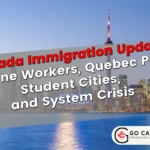July 2025 Canada immigration updates: Express Entry Draw #356 issues 356 PNP ITAs, IRCC plans mandatory IMP language testing by 2027, 2026-2028 Levels Plan consultations begin, and Atlantic Canada thrives via immigration. Go Canada Services offers expert immigration support.
Canada Immigration Updates July 2025: Express Entry, IMP Testing, Levels Plan, and Atlantic Canada
IMP language testing 2027 Introduction
July 2025 marks pivotal changes in Canada’s immigration framework, balancing economic needs, integration, and regional growth. Immigration, Refugees and Citizenship Canada (IRCC) held Express Entry Draw #356, targeting Provincial Nominee Program (PNP) candidates, proposed mandatory language testing for International Mobility Program (IMP) work permits by 2027, launched consultations for the 2026-2028 Immigration Levels Plan, and highlighted Atlantic Canada’s immigration-driven economic growth. These align with the 2025–2027 Immigration Levels Plan, targeting 395,000 permanent residents and 673,650 temporary residents in 2025. Additional updates include marine worker guidelines, Quebec’s PGP cap, and QS student city rankings. Go Canada Services, a trusted immigration firm since 2004, offers expert guidance. This article explores these developments and their implications.
Express Entry Draw #356: PNP Candidates
On July 21, 2025, IRCC conducted Express Entry Draw #356, issuing 356 Invitations to Apply (ITAs) to PNP candidates with a minimum Comprehensive Ranking System (CRS) score of 788, up 38 points from the previous PNP draw (July 7, 356 ITAs, CRS 750). Key details:
- Tie-Breaking Rule: Applied to profiles submitted before June 5, 2025, at 23:50:45 UTC.
- Context: With 256,914 profiles in the Express Entry pool as of July 20, 2025, IRCC has issued 45,403 ITAs in 2025, including 6,053 for PNP candidates. The high CRS reflects increased competition and provincial selectivity.
- PNP Impact: Provincial nominations add 600 CRS points, making PNP a critical pathway for permanent residency, especially with no all-program draws in 2025.
For Express Entry or PNP support, visit Go Canada Services’ Permanent Residency Services.
Mandatory Language Testing for IMP Work Permits by 2027
IRCC’s 2025–2027 Forward Regulatory Plan proposes mandatory third-party language proficiency testing for certain IMP work permit applicants by 2027. Key points:
- Objective: Enhance reliability of language assessments to ensure successful workforce integration, improve economic outcomes, and boost permanent residency transitions.
- Impact: Businesses may face a smaller candidate pool, but language-proficient workers are expected to have higher retention rates. Eligible IMP streams include significant benefit categories (e.g., intra-company transfers, Francophone Mobility).
- Implementation: Testing will align with standards like IELTS or CELPIP, with details to be finalized post-consultation.
This follows IRCC’s focus on skilled worker integration, as seen in the 2025–2027 Levels Plan’s 5% temporary resident target by 2026. For IMP work permit guidance, contact Go Canada Services’ Work Permit Services.
2026-2028 Immigration Levels Plan Consultations
IRCC launched consultations for the 2026–2028 Immigration Levels Plan from July 21 to August 17, 2025, aiming for sustainable growth. Key goals:
- Temporary Residents: Reduce to below 5% of Canada’s population by 2027 (from 673,650 in 2025 to 543,600 by 2027), with international students comprising 56–59% of arrivals.
- Permanent Residents: Stabilize at under 1% of population annually (380,000 in 2026, 365,000 in 2027).
- Francophone Immigration: Increase to 12% outside Quebec by 2029, up from 8.5% in 2025, to support Francophone communities.
- Engagement: Public and stakeholder feedback via online surveys, focusing on economic needs, housing, and infrastructure.
IRCC’s holistic approach includes collaboration with provinces, territories, and Indigenous groups. Participate at Canada.ca Immigration Consultations. For consultation insights, contact Go Canada Services.
Atlantic Canada’s Immigration-Driven Economic Renaissance
Atlantic Canada (Nova Scotia, New Brunswick, Prince Edward Island, Newfoundland and Labrador) is experiencing an economic transformation fueled by immigration, per Toward Prosperity by Don Mills and David Campbell (2025). Highlights:
- Demographic Solution: Immigration counters an aging population and low birth rates, with Nova Scotia targeting a doubled population by 2060.
- Economic Impact: Recent immigration has boosted GDP growth (e.g., PEI’s 3.6% in 2024) via programs like the Atlantic Immigration Program (AIP), which supports employer-driven recruitment.
- National Contrast: While federal leaders like Prime Minister Carney and Pierre Poilievre push for immigration caps due to housing and service strains, Atlantic provinces leverage immigration for growth.
For AIP or regional immigration support, explore Go Canada Services’ Free Assessment.
Other Key Updates
- Marine Workers (IMP): July 18, 2025, guidelines clarify work permit requirements under paragraph 186(s), impacting marine roles like retrofit workers.
- Quebec PGP Cap: No new parent/grandparent applications until June 26, 2026, due to a 13,000 cap.
- QS Student Cities 2026: Montreal (18th), Toronto (22nd), Vancouver (29th), Ottawa (80th) rank globally, with affordability challenges.
- Immigration Crisis: 500,000 undocumented residents and 17,000 admitted with criminal convictions prompt reform calls.
- Alberta AAIP Draws: 382 candidates invited in July 2025 across healthcare, agriculture, aviation, and law enforcement.
- PEI PNP Draw: 39 skilled worker ITAs issued on July 17, 2025.
- Nova Scotia Priorities: Focus on healthcare, construction, and social assistance for work permit renewals.
- CUAET Extension: Ukrainians can apply for work/study permits until March 31, 2026.
Immigration and Settlement Strategies
- PNP Candidates: Boost CRS scores via language tests (CLB 7+) or additional Canadian work experience to compete in high-CRS PNP draws like #356.
- IMP Applicants: Prepare for 2027 language testing by improving proficiency now (e.g., IELTS/CELPIP). Target significant benefit streams for eligibility.
- Atlantic Canada Applicants: Explore AIP for employer-driven pathways, especially in Nova Scotia or PEI, with job offers in healthcare or trades.
- Levels Plan Feedback: Submit input by August 17, 2025, to influence 2026–2028 targets, focusing on regional labor needs or Francophone integration.
For tailored strategies, start with Go Canada Services’ Free Assessment.

Frequently Asked Questions
- What was Express Entry Draw #356?
On July 21, 2025, IRCC issued 356 ITAs to PNP candidates with a minimum CRS score of 788, using a tie-breaking rule of June 5, 2025, at 23:50:45 UTC. - What is IRCC’s plan for IMP language testing?
By 2027, mandatory third-party language testing will apply to certain IMP work permit applicants to enhance integration and economic outcomes. - What are the 2026–2028 Immigration Levels Plan goals?
Reduce temporary residents to below 5% by 2027, stabilize permanent residents under 1% annually, and increase Francophone immigration to 12% outside Quebec by 2029. - How is immigration transforming Atlantic Canada?
Immigration drives economic growth in Atlantic provinces, countering demographic decline, with Nova Scotia aiming to double its population by 2060.
Why Choose Go Canada Services?
Go Canada Services excels in navigating Canada’s immigration pathways, offering solutions for Permanent Residency, Work Permits, Study Permits, and Visitor Visas. Their regulated consultants ensure compliance with IRCC and provincial requirements. Start with a Free Assessment or contact them at Go Canada Services’ Contact Page.
Call to Action
Begin your journey to Canada with Go Canada Services. Schedule a consultation for immigration, work, or settlement support. Satisfied with their services? Leave a review on Google.


